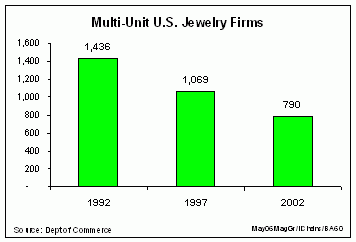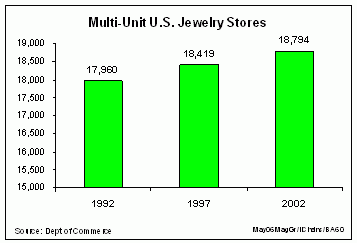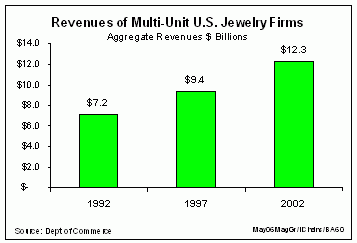IDEX Online Research: Industry Consolidation Has Occurred Mostly Among Chain Jewelers
June 06, 06
(The article below has been excerpted and updated from our May 2006 Idex Magazine)
Consolidation via merger and acquisition activity in the U.S. jewelry industry has taken place mostly among the chain jewelers. Based on data from the most recent government Business Census, the number of multi-unit specialty jewelers in the
Unfortunately, there is almost no consolidation among single-store jewelers. They are simply going out of business. When single-store jewelers attempt to sell out, they find that there are few buyers. Thus, they are often forced to liquidate with “Going Out Of Business” sales.
Chain Jewelers: A Valuable Commodity
Chain jewelers seem to be a valuable commodity; there are buyers who are ready, willing, and able to acquire chains. Recent buyers of chain jewelers include three types: 1) industry buyers (usually another chain such as Finlay’s acquisition of Carlyle); 2) financial investors (Wall Street investment firms such as Berkshire Hathaway, which owns Borsheims, Ben Bridge, and Helzberg); and 3) strategic buyers (typically an entity that wants to get into retailing, such as Aber Diamond’s acquisition of Harry Winston).
In a recent conference call with Wall Street analysts, Signet Group indicated that it might seek acquisitions in the U.S., as part of its expansion strategy for the company’s regional group of brands such as J.B. Robinson, Shaw’s, and others.
As the graph below illustrates, the number of multi-unit firms has declined from 1,436 in 1992 to 790 in 2002, a decline of nearly 50 percent.

Further, as the graph below illustrates, the number of stores that are operated by multi-unit chains has risen, but only moderately, over the past ten years.

These two graphs, in combination with other industry information, tell a series of stories about the jewelry industry, including the following:
· Most of the mergers and acquisitions have occurred among chain jewelers over the past decade. There is not much merger or acquisition activity among single-store operators. Based on Jewelers Board of Trade statistics, independents tend to simply run a going-out-of-business sale when the owners retire.
· The chains are not adding stores at a rapid pace. This is a most interesting statistic – most people would probably guess that the chain jewelers are not only acquiring their competition, but they are also opening new stores. The Business Census data tell us that net-net, very few chains are actually expanding. There are two reasons for this:
· Chains like Zale have added few new stores over the past several years. The only exception is
· When a new chain store opens, another store in the same chain often closes. In other words, many new stores are simply replacement units for older stores.
Sales from Multi-Unit Chains Rising Rapidly
While the number of stores operated by chain jewelers has remained relatively static, aggregate jewelry revenues from those stores has risen sharply, as the graph below illustrates.

Revenues for the multi-store chains have risen faster than revenue per store for the single-store independents. Over the past ten years, aggregate revenues for multi-unit jewelers have risen at an 11.3 percent CAGR while aggregate revenues for single-store jewelers have risen by a more moderate 10.1 percent CAGR. In part, this has been the fuel behind the market share increase which multi-store jewelers have experienced over the past decade.